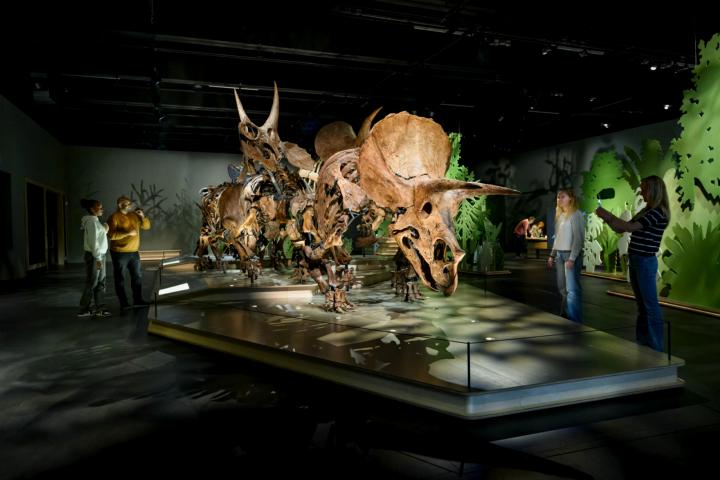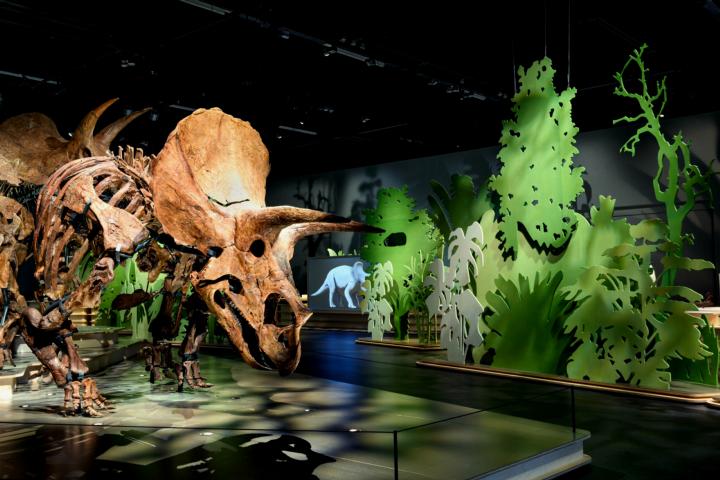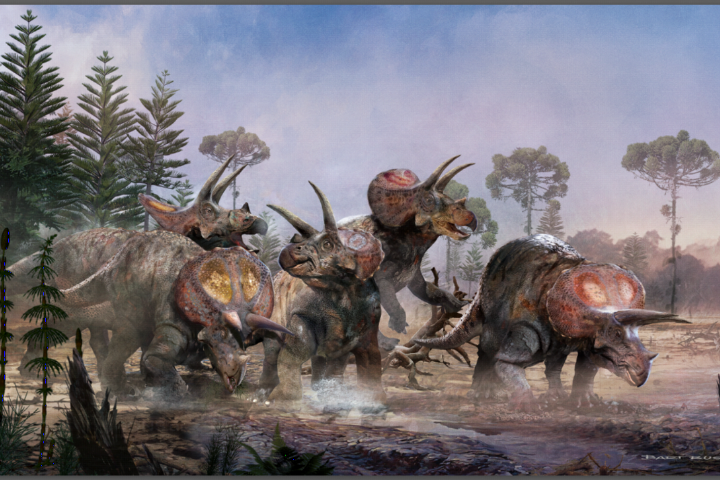
Starting 11 years ago, Naturalis has dug op no less than six Triceratops skeletons. Researchers, preparation workers, students and volunteers joined forces at the dig site in Wyoming (US) and excavated over 1,200 bones and bone fragments over the course of six field seasons.
Five of these six skeletons were found together. Research by our paleontologists indicates that they lived and died together, as a herd. The sixth individual can already be seen in Naturalis, in the Dinosaur Era exhibition. It is not a part of the herd, it was found in a separate site, a few meters higher.
Images ofTriceratops
Looking for anything in particular? Or interested in taking your own photos? Get in touch with our communications department through communicatie@naturalis.nl.
We have a lot of film and video material that you can use freely (if you use the credits indicated in the file name).

Triceratops horridus
The name Triceratops literally means "three horn face". The popular plant-eating dinosaur had three enormous horns, the iconic neck shield and could grow up to 8 meters long. Weighing in at 5,500 kg, it was over three times as heavy as a rhinoceros, and the biggest horned dinosaur to ever live. Despite the imposing presence, it was a herbivore. Their biggest enemy was Tyrannosaurus rex. At the end of the Cretaceous Era, 67-66 million years ago, they roamed what is now the Western US.
Facts & Figures
| Name | Triceratops horridus |
| Meaning | Horrifying three horn face |
| Length | Up to 8 meters |
| Weight | 5500 kg |
| Period | Cretaceous |
| Bones per animal | Over 300 |
Expeditionsto the States
The bones were discovered in 2013. Then there were digs every summer from 2015 to 2019. Work was done in teams, with typically ten to fifteen people at the dig site for several weeks.
Facts about the find
| Year | 2013 (Naturalis and the Black Hills Institute) |
| Start of excavation | 2015 (Naturalis) |
| End of excavation | 2019 (the last pieces arrived in Leiden in 2022) |
| End of prepping | 2024 |
| Location | Close to Newcastle, Wyoming (VS) |
| Number of bones | Over 1.200 (bones and fragments) |
| Age | Late Cretaceous (Maastrichtien), over 67 million years |
Researchingthe herd
Dinosaur movies, toys and books might give you the idea that everything about this 67 year old dinosaurs is already studied and known. Far from it! Until quite recently, only two relatively complete skeletons of this giant reptile existed. Countless questions were - and are - still open.
- Did they live alone or in groups?
- How did these animals die so close to each other, and how were they preserved as fossils?
- What did their skin look like?
- What exactly did they eat?
- Where they warm-blooded? And how quickly did they grow?
- How fast were they?
- Those horns, did they protect them from Tyrannosaurus rex, or were they more for show?
PhD
Jimmy de Rooij wrote his PhD thesis about the skeletons. The biggest mystery: "How come we found so many bones together?" Combining sedimentology, stratigraphy, research into the geological contexts and analysis of the bones, De Rooij found some answers. Researching the growth lines in the bones also helped determine which individual the bones belonged to. A study of the tooth enamel revealed subtle chemical details that give information about growth, diet, migration, environment and more. The research was done with prestigious research institutes in the Netherlands and abroad.
Relatednews
Unique dinosaur exhibition at Naturalis, the Netherlands
Naturalis shows off unique find in a new triceratops exhibition
Triceratops teamed up Research shows that five three-horned dinosaurs lived - and died - together
Triceratops the herd
Unique find
In 2013 a team of Naturalis experts found something unique in Wyoming. Over the course of several expeditions to the site, they found many hundreds of bones from the world-famous dinosaurs Triceratops horridus. They turned out to be five individuals from one group. This means that Naturalis has the biggest collection of triceratopses in the world, and the only one proven to have been a herd.


